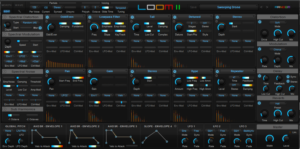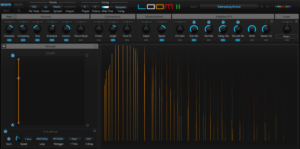By Air Music Tech
Overview
Loom II is a semi-modular additive synth which offers a number of features not widely available in other additive synths that I’ve used. Loom is not free (it normally retails for $99), but I recently picked it up at a huge discount as part of the AIR Super Synth Pack (Loom II, Hybrid 3, and theRiser) at VST Buzz for under $25.
tl;dr Loom offers unique opportunities for sound design outside of those offered by conventional synthesizers by creating a simple and intuitive way to harness the sometimes overwhelming power of additive synthesis.
The interface of Loom is split into two main screens, the Edit screen and the Morph screen. These correspond to the two main modes of using Loom: sound design and performance.
At the core of Loom, on the Edit screen, is a configurable chain of up to 10 modules, which generate a whole set of partials and then modify the amplitude and frequency of the partials through a series of filters, modulations, spectral morphing, and other spectral modifications. A set of envelope generators and LFOs allow for modulation of the primary control knob for each module. A small selection of effects are also available: distortion, modulation (chorus/flanger), delay, and reverb. Each of the main modules has its own small spectral display so you can see how the spectrum changes as it progresses through the modules.

The Morph screen, on the other hand, presents a set of macro knobs, each of which are preconfigured to modify particular parameters on the edit page. This is combined with a XY pad which morphs between up to 4 user-definable configurations of the macro parameters. You can draw paths on the XY pad to easily automate the morphing and create a range of rhythmic effects. Lastly, there is a live spectral display of the partials as sounds are playing.

Loom II comes with a huge and diverse set of presets (something like 850), and additional preset packs are available (at least one of which is free).
The Loom presets show off the unique sound design capabilites of this synth. Besides the normal types of presets offered by most synths (leads, basses, etc.) and the inharmonic sounds of bells and percussion that are offered by some other additive synths, the many opportunities for morphing and modulation that Loom offers make it easy to design rich soundscapes, lush moving pads, and other atmospheric sounds.
FEATURES
- 10 modular slots in seven categories: Basic Modules (generators), Filter Modules, Effect Modules, Rhythmical Modules, Time Modules, Tools, and Wave-Based Modules. Roughly 30 modules in all. Each module has a main control parameter knob, and up to four other parameter sliders.
- Spectral Effects Module with spectral distortion, spectral modulation, spectral noise, and 2 sub oscillators
- 4 envelope generators: 3 AHDSR EGs, and one unique “slope” EG which can be used for various types of riser or swell effects.
- 3 LFOs, each with a “Fade” knob that controls the envelope of the LFO.
- Effects Module with distortion, modulation (chorus/phaser), delay, and reverb
- Ability to use up to two wave samples in a vocoder-type effect.
- 17 predefined morphing macro knobs: 6 sound, 3 dynamic, 2 modulation, 6 master/FX, plus one user-assignable macro knob.
- An XY pad for morphing between up to 4 user-definable variants of a patch, along with the ability to automate the XY pad with user-defined paths which can be separately saved. Close to 50 different paths are built-in.
- An extensive library of presets (some 850 in all) divided into categories: leads, basses, wobbles, pads, moving pads, atmospheres, polys, organs, bells, percussive, swells, waves, sfx. Additionally, well over two hundred presets which show off particular capabilities of Loom are grouped into the “Meet Loom” and “Meet Loom 2” categories.
Overall
Pros
- Unique sound design capabilites not present in conventional synths or most other additive synths.
- Interface seems well thought out. Division into Edit and Morph makes a lot of sense, and the performance-oriented features are nice.
- Huge library of well-designed presets.
- Excellent value for money.
Cons
- Sparse documentation. In many or most cases the only specific documentation for modules and controls is offered by tooltips. Precise function of the morph knobs is somewhat mysterious. There are other obscure points in the interface.
- The sound and display glitch when moving to and from the Waves screen while a sound is playing.
- Other minor display glitching issues.
- Minor complaints about typos or grammar in places.
Rating
8.5/10. Loom has quickly become my go-to additive synth.
Loom II is available from Air Music Tech as well as other retailers.
Details
I would really like to create a detailed explanation of each of the modules and morphing possibilities, as much for my own reference as for the review, but I also want to create some more reviews, so… TBD.